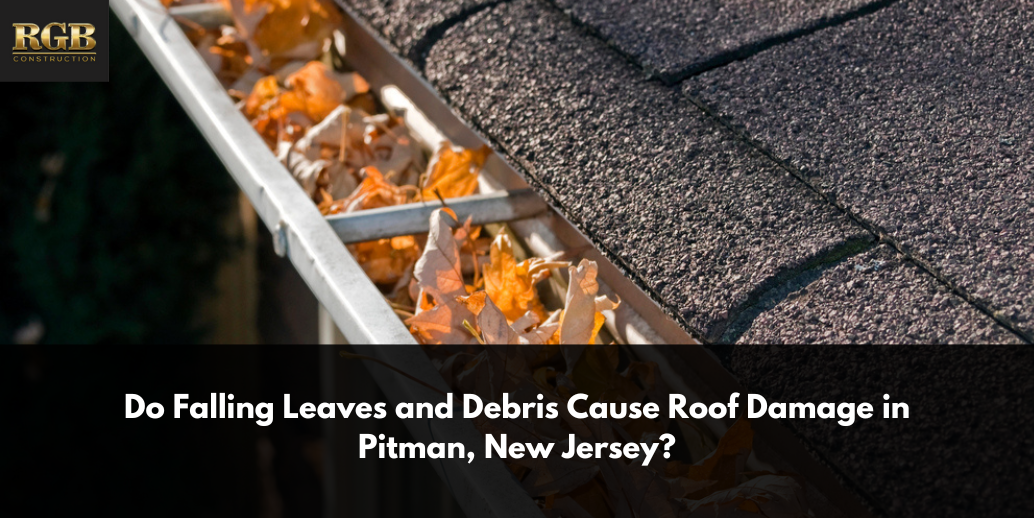Throughout the year, leaves and debris are bound to fall from the trees surrounding your property. In Pitman, the more leaves that fall, the more the scenery becomes a tapestry of reds, oranges, and yellows. While this may be beautiful, the leaves and bits of debris can pose a significant threat to your home’s roof. Let’s take a look at the ways falling leaves and debris can cause roof damage and provide you with some insight into how you can protect your roof in Pitman, NJ.
Key Takeaways
- Falling leaves and debris, while picturesque, can lead to severe roof damage by clogging gutters and downspouts, resulting in water overflow that undermines the integrity of the roof and its supporting structures.
- The accumulation of organic material on the roof traps moisture, creating an environment conducive to the growth of mold, mildew, and algae, which accelerates the deterioration of roofing materials and can cause leaks.
- Blocked roof valleys, where two slopes converge, impede the efficient flow of water, causing pooling and leaks; in winter, these blockages can exacerbate the problem by trapping snow and ice, adding weight and moisture.
- Regular roof inspections, installation of gutter guards, and trimming overhanging branches are essential preventative measures that homeowners can take to mitigate the risk of roof damage caused by falling leaves and debris.
The Dangers of Falling Leaves and Debris
One of the most overlooked aspects of home maintenance during the fall is the impact of leaves and debris on the roof. When leaves fall and settle on your roof, they can create a series of problems that, if left unchecked, may lead to serious damage.
1. Clogged Gutters and Downspouts
Leaves, twigs, and other debris can quickly fill up gutters and downspouts, leading to blockages. When gutters are clogged, rainwater cannot flow freely and may overflow, spilling over the sides and pooling around the foundation of your home. This overflow can cause water damage to your roof, fascia, and soffit, and may even lead to basement flooding.
2. Trapped Moisture
Leaves that collect on the roof can trap moisture against the shingles. This trapped moisture creates an ideal environment for mold, mildew, and algae to grow. Over time, these organisms can deteriorate the roofing materials, leading to weakened shingles and potentially causing leaks.
3. Added Weight and Structural Stress
When leaves become wet, they can add significant weight to your roof. While a few leaves might not seem like much, a thick layer of wet, decomposing leaves can place undue stress on your roofing structure. For older roofs, this added weight can lead to sagging or even structural damage, compromising the integrity of the roof.
4. Blocked Roof Valleys
Roof valleys, where two roof slopes meet, are particularly susceptible to leaf accumulation. These V-shaped areas are designed to channel water off the roof efficiently. When they become blocked with leaves and debris, water can pool and potentially seep into the roof, causing leaks and water damage to the underlying structure.
In the winter, blocked roof valleys can also lead to piled up snow on the roof. That can lead to extra weight and too much moisture trapped on the roof. By clearing the valleys, you give the snow and ice a path to travel as it melts.
Preventative Measures for Homeowners in Pitman, New Jersey
The best way to keep falling leaves and debris from damaging your roof is to perform routine maintenance. Here are some steps you can take:
1. Clean Regularly
You always want to know that your gutters and downspouts are cleaned regularly, especially during the fall. Removing leaves and debris helps maintain proper water flow and reduces the risk of water damage.
2. Install Gutter Guards
Gutter guards can be an effective solution to prevent leaves and debris from clogging your gutters. These guards allow water to flow through while keeping larger debris out, reducing the need for frequent cleaning.
Consider upgrading to seamless gutters by RGB Construction.
3. Schedule Roof Inspections
Regular roof inspections by a professional roofing company like RGB Construction can help identify and address potential issues before they escalate. Professional inspections can catch signs of damage early, saving you from costly repairs down the line.
4. Trim Overhanging Branches
Trimming trees and branches that hang over your roof can significantly reduce the number of leaves that fall onto it. This simple step can help keep your roof clear and prevent debris buildup.
Contact a Pitman Roofing Contractor Today
When the leaves start to fall in Pitman, NJ, there is also the potential for roof damage to occur. Falling leaves and debris can cause roofing issues that lead to bigger woes for homeowners. By staying proactive and taking the necessary preventative measures, you can protect your home and ensure your roof remains in excellent condition throughout the year. Contact the RGB Construction team today to learn more about our services.







